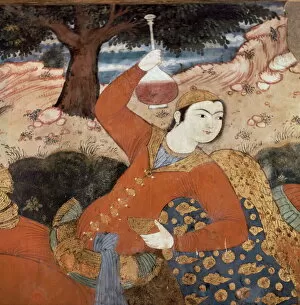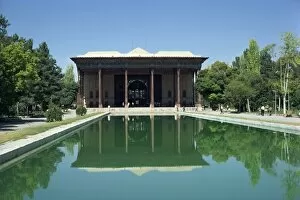Chehel Sotoun Collection
Chehel Sotoun, a mesmerizing palace located in Isfahan, Iran, is adorned with breathtaking mural paintings that transport visitors to a bygone era
For sale as Licensed Images
Choose your image, Select your licence and Download the media
Chehel Sotoun, a mesmerizing palace located in Isfahan, Iran, is adorned with breathtaking mural paintings that transport visitors to a bygone era. One of the most captivating frescoes within this architectural marvel is the Banquet scene from 1647. As you gaze upon it, you can almost hear the laughter and chatter of guests as they indulge in a sumptuous feast fit for royalty. In another masterpiece titled "Female figure, " also from 1647, an elegant woman stands gracefully amidst intricate designs. Her poise and beauty are captured flawlessly on the walls of Chehel Sotoun, leaving viewers enchanted by her timeless allure. A heartwarming scene unfolds in "Woman with little girl and seated characters. " Painted in 1647, this fresco depicts a motherly figure tenderly holding her young daughter's hand while surrounded by other seated individuals. It serves as a reminder of the importance of family bonds and love that transcends time. The grandeur of Shah Abbas I Great is immortalized in "Shah Abbas I Great receiving Nadr Vali Muhammad Khan. " This historical event showcases his diplomatic prowess as he welcomes Nadr Vali Muhammad Khan from the Khanate of Bukhara into his realm. The vivid colors and attention to detail bring this momentous encounter to life before your eyes. "Female figure with glass and bottle" portrays an enchanting lady indulging in leisurely activities during ancient times. With delicate brushstrokes capturing every nuance, this artwork transports us back to an era where elegance was revered above all else. The theme continues with "Female figures with bottles" and "Female figures with glass and bottle. " These frescoes depict women engaged in social gatherings or perhaps even celebrations - their graceful movements frozen forever on these walls. One cannot help but be captivated by the depiction of historic battles such as the Battle of Taher-Abad or Battle of Merv, where Shah Ismail I triumphs over Muhammad.


